
Indigenous Australian art includes art made by Aboriginal Australian and Torres Strait Islander peoples, including collaborations with others. It includes works in a wide range of media including painting on leaves, bark painting, wood carving, rock carving, watercolour painting, sculpting, ceremonial clothing and sand painting; art by Indigenous Australians that pre-dates European colonisation by thousands of years, up to the present day.
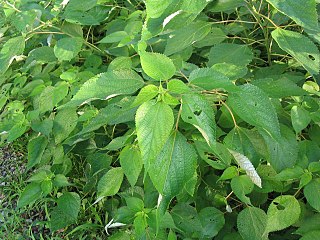
Ramie is a flowering plant in the nettle family Urticaceae, native to eastern Asia. It is a herbaceous perennial growing to 1.0–2.5 m tall; the leaves are heart-shaped, 7–15 cm (2.8–5.9 in) long and 6–12 cm (2.4–4.7 in) broad, and white on the underside with dense, small hairs—this gives it a silvery appearance; unlike stinging nettles, the hairs do not sting. The true ramie or China grass is also called Chinese plant or white ramie.
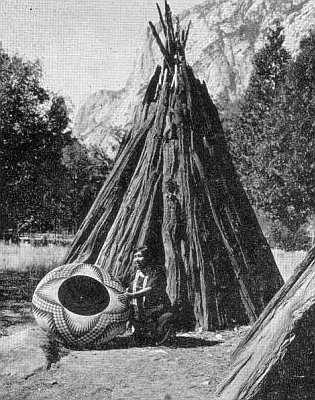
Basket weaving is the process of weaving or sewing pliable materials into three-dimensional artifacts, such as baskets, mats, mesh bags or even furniture. Craftspeople and artists specialized in making baskets may be known as basket makers and basket weavers. Basket weaving is also a rural craft.

Australian Aboriginal artefacts include a variety of cultural artefacts used by Aboriginal Australians. Most Aboriginal artefacts were multi-purpose and could be used for a variety of different occupations. Spears, clubs, boomerangs and shields were used generally as weapons for hunting and in warfare. Watercraft technology artefacts in the form of dugout and bark canoes were used for transport and for fishing. Stone artefacts include cutting tools and grinding stones to hunt and make food. Coolamons and carriers such as dillybags, allowed Aboriginal peoples to carry water, food and cradle babies. Message sticks were used for communication, and ornamental artefacts for decorative and ceremonial purposes. Aboriginal children’s toys were used to both entertain and educate.
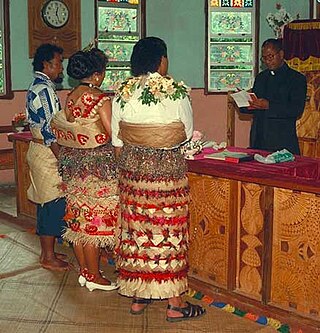
A taʻovala is an article of Tongan dress, a mat wrapped around the waist, worn by men and women, at all formal occasions, much like the tie for men in the European and North American culture. The ta'ovala is also commonly seen among the Fijian Lau Islands, and Wallis island, both regions once heavily influenced by Tongan hegemony and cultural diffusion.

Coolamon is an anglicised NSW Aboriginal word used to describe an Australian Aboriginal carrying vessel.

A dillybag or dilly bag is a traditional Australian Aboriginal bag generally woven from plant fibres. Dillybags are mainly designed and used by women to gather and transport food, and are most commonly found in the northern parts of Australia.
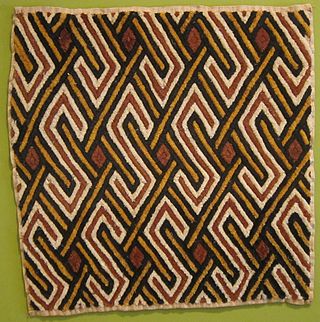
African textiles are textiles from various locations across the African continent. Across Africa, there are many distinctive styles, techniques, dyeing methods, and decorative and functional purposes. These textiles hold cultural significance and also have significance as historical documents of African design.
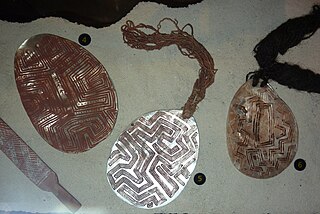
Riji are the pearl shells traditionally worn by Aboriginal men in the north-west part of Australia, around present day Broome. The word riji is from the Bardi language. Another word for it is jakuli.

The Andean textile tradition once spanned from the Pre-Columbian to the Colonial era throughout the western coast of South America, but was mainly concentrated in Peru. The arid desert conditions along the coast of Peru have allowed for the preservation of these dyed textiles, which can date to 6000 years old. Many of the surviving textile samples were from funerary bundles, however, these textiles also encompassed a variety of functions. These functions included the use of woven textiles for ceremonial clothing or cloth armor as well as knotted fibers for record-keeping. The textile arts were instrumental in political negotiations, and were used as diplomatic tools that were exchanged between groups. Textiles were also used to communicate wealth, social status, and regional affiliation with others. The cultural emphasis on the textile arts was often based on the believed spiritual and metaphysical qualities of the origins of materials used, as well as cosmological and symbolic messages within the visual appearance of the textiles. Traditionally, the thread used for textiles was spun from indigenous cotton plants, as well as alpaca and llama wool.

Māori traditional textiles are the indigenous textiles of the Māori people of New Zealand. The organisation Te Roopu Raranga Whatu o Aotearoa, the national Māori weavers' collective, aims to preserve and foster the skills of making and using these materials.

Phormium tenax is an evergreen perennial plant native to New Zealand and Norfolk Island that is an important fibre plant and a popular ornamental plant. The plant grows as a clump of long, straplike leaves, up to two metres long, from which arises a much taller flowering shoot, with dramatic yellow or red flowers.
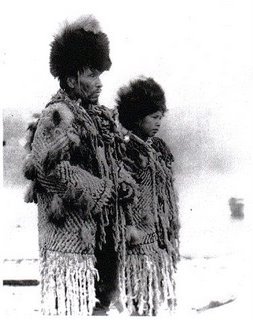
Salish are skilled weavers and knitters of the Pacific Northwest. They are most noted for their beautiful twill blankets many of which are very old. The adoption of new fabrics, dyes, and weaving techniques allow us to study a wide variety of Salish weavings today.

A bag is a common tool in the form of a non-rigid container. The use of bags predates recorded history, with the earliest bags being lengths of animal skin, cotton, or woven plant fibers, folded up at the edges and secured in that shape with strings of the same material.
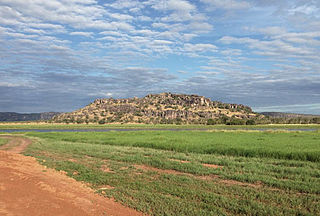
Injalak Arts is a non-profit, community owned Aboriginal art centre located in Gunbalanya in West Arnhem Land in the Northern Territory of Australia. It was incorporated in 1989. It is known for artists working in a primarily figurative style, and continuing and developing the West Arnhem rock art tradition. It is also known for pandanus weavings. Artists are mostly Kunwinjku people; however, artists from many language groups across Arnhem Land are represented. While working within the continuous art history of the Arnhem region, Injalak Arts is part of the wider contemporary Aboriginal Art movement, which has made a large impact on the Australian and international art world.

The production of sculptural fibre objects has a long history within Aboriginal Australian culture. Historically, such objects had practical or ceremonial purposes, and some appeared in both contexts. The terms “art” and “craft” are difficult to apply in historical contexts, as they are not originally Aboriginal conceptual divisions. However, in a contemporary context, these objects are now generally regarded as contemporary art whenever they are presented as such. This categorisation is often applied to objects with historically practical or ceremonial applications, as well as a growing category of new fibre forms which have been innovated in the past decades and produced for a fine art market. The border between Aboriginal fibre sculpture and fibre craft is not clearly delineated, and some works may be regarded as either depending on the context of their display and use.

String is a long flexible structure made from fibers twisted together into a single strand, or from multiple such strands which are in turn twisted together. String is used to tie, bind, or hang other objects. It is also used as a material to make things, such as textiles, and in arts and crafts. String is a simple tool, and its use by humans is known to have been developed tens of thousands of years ago. In Mesoamerica, for example, string was invented some 20,000 to 30,000 years ago, and was made by twisting plant fibers together. String may also be a component in other tools, and in devices as diverse as weapons, musical instruments, and toys.

Regina Pilawuk Wilson is an Australian Aboriginal artist known for her paintings, printmaking and woven fiber-artworks. She paints syaws, warrgarri, and message sticks. Her work has been shown in many Australian and international museums, collections and galleries. She has won the General Painting category of the Telstra National Aboriginal & Torres Strait Islander Art Awards in 2003 for a syaw painting. Wilson has been a finalist for the Kate Challis RAKA Award, the Togart Award, and the Wynne Prize.
Lucy Malirrimurruwuy Armstrong Wanapuyngu is an Aboriginal Australian master fibre artist. She is an elder of the Gapuwiyak community, and is heavily involved in the transmission of knowledge dealing with fibre works. She has worked with anthropologist Louise Hamby, since 1995, and many of her works have been spotlighted at different art festivals, collections, galleries, and museums.
Anniebell Marrngamarrnga is an Aboriginal Australian artist from Maningrida in the Northern Territory of Australia. She is well known for her large-scale, intricate fibre sculptures.






















